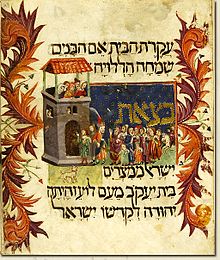
Aniconism in Judaism refers to the idea that Judaism forbids the creation of "graven images," commonly understood to mean the prohibition of idolatry and idol worship. While Judaism is a logocentric religion, Jews were not under a blanket ban on visual art, despite common assumptions to the contrary, and throughout Jewish history and the history of Jewish art, created architectural designs and decorations of synagogues, decorative funerary monuments, illuminated manuscripts, embroidery and other decorative or artistic religious items.[1]
In a refutation of the belief in an aniconic Judaism, and more generally in the underestimation of Jewish visual arts, modern secular historians believe that the phenomenon is a modern construction, and that "Jewish aniconism crystallized simultaneously with the construction of modern Jewish identities".[2] According to current scholarship, the notion of a total prohibition of figural representation in the Biblical and Hellenistic-Roman periods is untenable.[3][4]
Until the 20th century, Judaism was commonly believed to have been aniconic. The view was probably first challenged by Dávid Kaufmann, who marshalled a large and comprehensive corpus of data in order to prove it untenable. He was the first to popularize the term "Jewish art" in an article published in 1878, and is regarded as the founder of the scholarly discipline of Jewish art history. His disciple Dr. Samuel Krauss wrote in 1901:
As late as ten years ago it would have been absurd to speak about a Jewish art. It is Kaufmann's own merit to have uncovered this art. Not only did he have to prove that such an art existed, he also had to prove that it could exist, as he showed that the idea that the prohibition of images would obstruct the development of such an art was mistaken, and even established it as an irrefutable fact that the art in wide areas was not prohibited insofar as no worship was associated with it.[5]

- ^ Raphael, Melissa (2016-04-05), "Judaism and Visual Art", Oxford Research Encyclopedia of Religion, doi:10.1093/acrefore/9780199340378.013.98, ISBN 978-0-19-934037-8, retrieved 2024-09-14
- ^ "(Bland 2001:8)" (PDF). Archived from the original (PDF) on 2015-05-30. Retrieved 2012-09-19.
- ^ Joseph Gutmann: "The 'Second Commandment' and the image in Judaism." In Hebrew Union College Annual 32 (1961) 161-174. [= Id.: Sacred images: Studies in Jewish art from Antiquity to the Middle Ages. [Collected studies series, CS 303]. Northampton 1989. II. 161-174].
- ^ Joseph Gutmann: "Recent literature on Jewish art: a critical appraisal." In Jewish Book Annual 25 (5728/1967-1968) 167-169. See also Gabrielle Sed-Rajna's contribution to this volume.
- ^ Dávid Kaufmann and his collections Library of the Hungarian Academy of Sciences. Original source: Dr. Samuel Krauss: David Kaufmann. Eine Biographie, p. 45. Berlin 1901 (1902). "Noch vor zehn Jahren wäre es absurd gewesen, von einer jüdischen Kunst zu sprechen. Diese Kunst entdeckt zu haben, ist Kaufmann's eigenstes Verdienst. Nicht nur mußte er beweisen, daß eine solche Kunst existire, er mußte auch beweisen, daß sie existiren könne, indem er die Meinung, als stehe das Bilderverbot der Kunstentfaltung im Judenthum im Wege, als irrig erwies, er es vielmehr als unwiderlegbare Thatsache hinstellte, daß die Kunst auf flachem Raume nie verboten war, insofern kein Götzendienst sich daran knüpfte."